城市应急物流配送路径优化英文
城市应急救援中心选址及车辆路径优化研究评述与展望
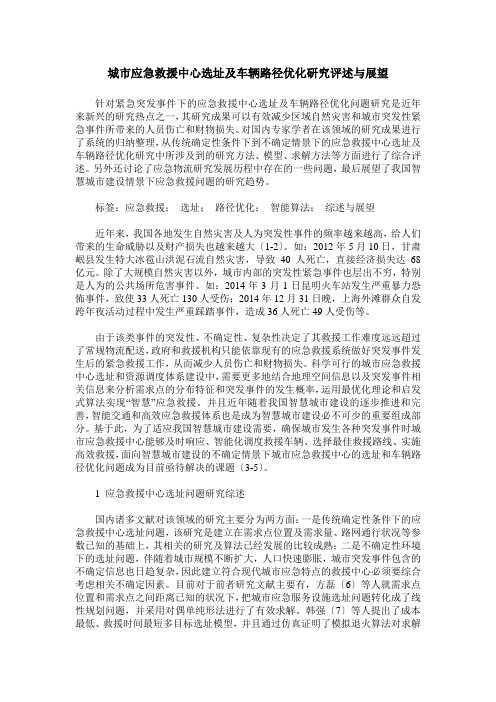
城市应急救援中心选址及车辆路径优化研究评述与展望针对紧急突发事件下的应急救援中心选址及车辆路径优化问题研究是近年来新兴的研究热点之一,其研究成果可以有效减少区域自然灾害和城市突发性紧急事件所带来的人员伤亡和财物损失。
对国内专家学者在该领域的研究成果进行了系统的归纳整理,从传统确定性条件下到不确定情景下的应急救援中心选址及车辆路径优化研究中所涉及到的研究方法、模型、求解方法等方面进行了综合评述。
另外还讨论了应急物流研究发展历程中存在的一些问题,最后展望了我国智慧城市建设情景下应急救援问题的研究趋势。
标签:应急救援;选址;路径优化;智能算法;综述与展望近年来,我国各地发生自然灾害及人为突发性事件的频率越来越高,给人们带来的生命威胁以及财产损失也越来越大〔1-2〕。
如:2012年5月10日,甘肃岷县发生特大冰雹山洪泥石流自然灾害,导致40人死亡,直接经济损失达68亿元。
除了大规模自然灾害以外,城市内部的突发性紧急事件也层出不穷,特别是人为的公共场所危害事件。
如:2014年3月1日昆明火车站发生严重暴力恐怖事件,致使33人死亡130人受伤;2014年12月31日晚,上海外滩群众自发跨年夜活动过程中发生严重踩踏事件,造成36人死亡49人受伤等。
由于该类事件的突发性、不确定性、复杂性决定了其救援工作难度远远超过了常规物流配送,政府和救援机构只能依靠现有的应急救援系统做好突发事件发生后的紧急救援工作,从而减少人员伤亡和财物损失。
科学可行的城市应急救援中心选址和资源调度体系建设中,需要更多地结合地理空间信息以及突发事件相关信息来分析需求点的分布特征和突发事件的发生概率,运用最优化理论和启发式算法实现“智慧”应急救援。
并且近年随着我国智慧城市建设的逐步推进和完善,智能交通和高效应急救援体系也是成为智慧城市建设必不可少的重要组成部分。
基于此,为了适应我国智慧城市建设需要,确保城市发生各种突发事件时城市应急救援中心能够及时响应、智能化调度救援车辆、选择最佳救援路线、实施高效救援,面向智慧城市建设的不确定情景下城市应急救援中心的选址和车辆路径优化问题成为目前亟待解决的课题〔3-5〕。
城市应急物流配送路径优化英文
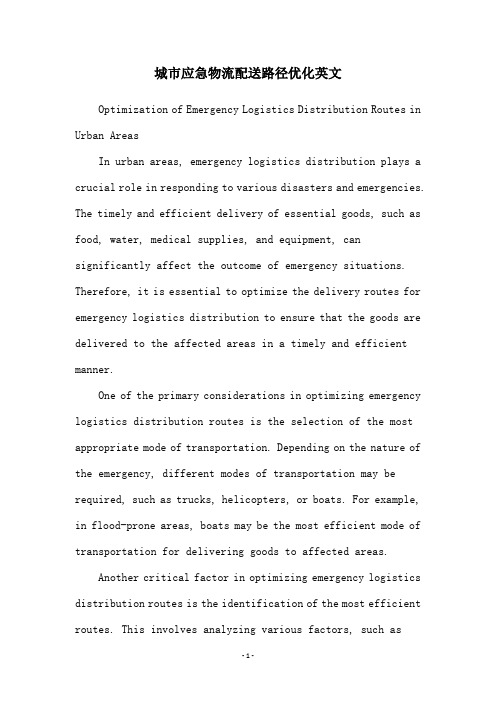
城市应急物流配送路径优化英文Optimization of Emergency Logistics Distribution Routes in Urban AreasIn urban areas, emergency logistics distribution plays a crucial role in responding to various disasters and emergencies. The timely and efficient delivery of essential goods, such as food, water, medical supplies, and equipment, can significantly affect the outcome of emergency situations. Therefore, it is essential to optimize the delivery routes for emergency logistics distribution to ensure that the goods are delivered to the affected areas in a timely and efficient manner.One of the primary considerations in optimizing emergency logistics distribution routes is the selection of the most appropriate mode of transportation. Depending on the nature of the emergency, different modes of transportation may be required, such as trucks, helicopters, or boats. For example, in flood-prone areas, boats may be the most efficient mode of transportation for delivering goods to affected areas.Another critical factor in optimizing emergency logistics distribution routes is the identification of the most efficient routes. This involves analyzing various factors, such astraffic congestion, road conditions, and distance, to determine the quickest and safest routes for delivering goods. In some cases, alternative routes may need to be identified to avoid heavily congested areas or roadblocks caused by the emergency.The use of technology can also play a significant role in optimizing emergency logistics distribution routes. Geographic Information Systems (GIS) can be used to map out the affected areas and identify the optimal delivery routes. Real-time tracking systems can also be used to monitor the location of delivery vehicles and adjust the routes as needed. In conclusion, optimizing emergency logistics distribution routes in urban areas is crucial for the timely and efficient delivery of essential goods during emergencies and disasters. The selection of the most appropriate mode of transportation, identification of the most efficient routes, and the use of technology can all contribute to the success of emergency logistics distribution in urban areas.。
物流配送常用英文单词和常用句型

36.船务代理 shipping agency
37.国际货运代理 international freight forwarding agent
2019/8/30
40.报关 customs declaration
38.理货 tally 41.报关行 customs broker
39.国际货物运输保险 international transportation cargo insurance
SCM:Supply Chain Management供应链管理
T&T:Track and Trace位置追踪
OA办公自动化系统 FMS财务管理系统 QMS质量管理系统 HRMS人力资源管理系统
ECS:CEnvironmentally Conscious Supply Chain环境意识供应链 ESC: E2n0v19ir/o8/n3m0 entally Supply Chain环境供应链 GSCM :Green Supply Chain Management绿色供应链2管理
20.输送机 conveyor
21.自动导引车 automatic guided vehicle (AGV)
22.箱式车 box car
23.集装箱 container
25.特种货物集装箱 specific cargo container
28.公路集装箱中转站 inland container depot
28.增值物流服务 value-added logistics service
29.供应链 supply chain
30.条码 bar code
31.电子数据交换 electronic data interch2a01n9g/e8/3(E0DI)
模糊条件下应急物资公平配送多目标优化模型
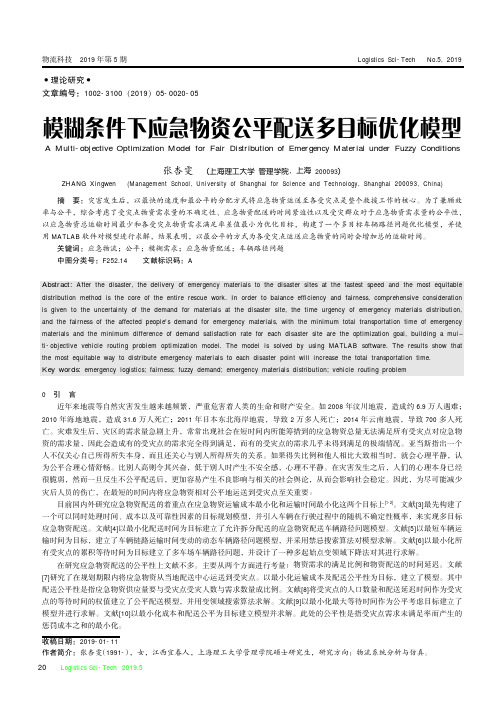
在研究应急物资配送的公平性上文献不多。主要从两个方面进行考量:物资需求的满足比例和物资配送的时间延迟。文献 [7]研究了在规划期限内将应急物资从当地配送中心运送到受灾点。以最小化运输成本及配送公平性为目标,建立了模型。其中 配送公平性是指应急物资供应量要与受灾点受灾人数与需求数量成比例。文献[8]将受灾点的人口数量和配送延迟时间作为受灾 点的等待时间的权值建立了公平配送模型,并用变领域搜索算法求解。文献[9]以最小化最大等待时间作为公平考虑目标建立了 模型并进行求解。文献[10]以最小化成本和配送公平为目标建立模型并求解。此处的公平性是指受灾点需求未满足率而产生的 惩罚成本之和的最小化。
关键词:应急物流;公平;模糊需求;应急物资配送;车辆路径问题 中图分类号:F252.14 文献标识码:A
Abstract: After the disaster, the delivery of emergency materials to the disaster sites at the fastest speed and the most equitable distribution method is the core of the entire rescue work. In order to balance efficiency and fairness, comprehensive consideration is given to the uncertainty of the demand for materials at the disaster site, the time urgency of emergency materials distribution, and the fairness of the affected people's demand for emergency materials, with the minimum total transportation time of emergency materials and the minimum difference of demand satisfaction rate for each disaster site are the optimization goal, building a mul原 ti-objective vehicle routing problem optimization model. The model is solved by using MATLAB software. The results show that the most equitable way to distribute emergency materials to each disaster point will increase the total transportation time. Key words: emergency logistics; fairness; fuzzy demand; emergency materials distribution; vehicle routing problem
突发公共事件下应急物流中的优化运输问题的研究

突发公共事件下应急物流中的优化运输问题的研究一、本文概述随着社会的快速发展和全球化的深入推进,突发公共事件,如自然灾害、疫情爆发、事故灾难等,对人类社会的影响日益显著。
这些事件往往导致物资短缺、交通受阻、信息传递不畅等问题,对应急物流系统提出了巨大的挑战。
因此,如何在突发公共事件下优化运输问题,提高应急物流的效率,成为了当前研究的热点和难点。
本文旨在探讨突发公共事件下应急物流中的优化运输问题。
我们将对突发公共事件和应急物流的概念进行界定,明确研究范围和对象。
我们将分析突发公共事件对运输系统的影响,包括物资需求的变化、运输网络的破坏、运输能力的下降等。
在此基础上,我们将探讨应急物流中优化运输问题的关键要素,如运输路径的选择、运输资源的调配、运输成本的控制等。
接下来,我们将通过文献综述和案例分析的方法,深入探究突发公共事件下应急物流优化运输问题的研究现状和发展趋势。
我们将总结前人的研究成果和经验教训,分析现有研究的不足和局限性,为后续的研究提供借鉴和参考。
我们将提出一种基于多目标优化的应急物流运输模型,并通过仿真实验验证其有效性和可行性。
该模型将综合考虑运输时间、运输成本、运输风险等多个因素,以实现应急物流运输的最优化。
我们期望通过本研究,能够为突发公共事件下的应急物流运输问题提供新的解决思路和方法,为未来的应急物流管理和实践提供有益的参考和指导。
二、文献综述在应对突发公共事件的过程中,应急物流的优化运输问题一直备受关注。
众多学者针对这一领域进行了深入的研究和探讨。
本节将对前人的研究成果进行系统的文献综述,旨在明确研究现状、挖掘研究不足,为本研究的深入展开提供理论基础和研究方向。
在应急物流的研究方面,学者们主要关注了应急物流体系的构建、应急预案的制定与实施、应急资源的调度与分配等方面。
其中,优化运输问题是应急物流研究中的核心内容之一。
运输路径的选择、运输资源的调配、运输过程的优化等问题都受到了广泛关注。
物流行业物流配送路径优化方案
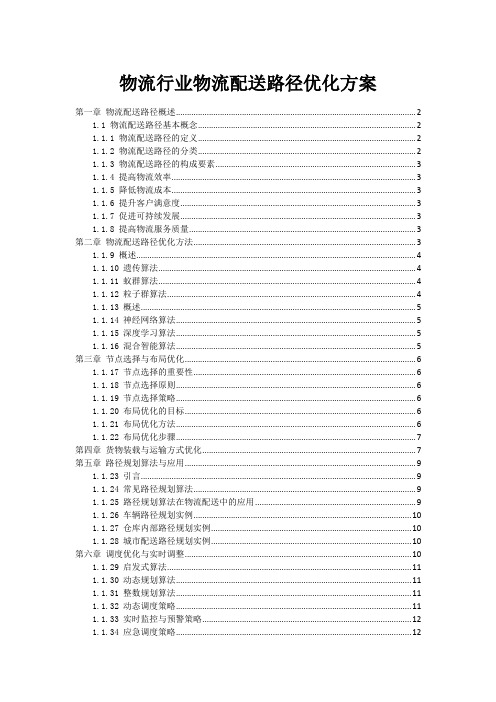
物流行业物流配送路径优化方案第一章物流配送路径概述 (2)1.1 物流配送路径基本概念 (2)1.1.1 物流配送路径的定义 (2)1.1.2 物流配送路径的分类 (2)1.1.3 物流配送路径的构成要素 (3)1.1.4 提高物流效率 (3)1.1.5 降低物流成本 (3)1.1.6 提升客户满意度 (3)1.1.7 促进可持续发展 (3)1.1.8 提高物流服务质量 (3)第二章物流配送路径优化方法 (3)1.1.9 概述 (4)1.1.10 遗传算法 (4)1.1.11 蚁群算法 (4)1.1.12 粒子群算法 (4)1.1.13 概述 (5)1.1.14 神经网络算法 (5)1.1.15 深度学习算法 (5)1.1.16 混合智能算法 (5)第三章节点选择与布局优化 (6)1.1.17 节点选择的重要性 (6)1.1.18 节点选择原则 (6)1.1.19 节点选择策略 (6)1.1.20 布局优化的目标 (6)1.1.21 布局优化方法 (6)1.1.22 布局优化步骤 (7)第四章货物装载与运输方式优化 (7)第五章路径规划算法与应用 (9)1.1.23 引言 (9)1.1.24 常见路径规划算法 (9)1.1.25 路径规划算法在物流配送中的应用 (9)1.1.26 车辆路径规划实例 (10)1.1.27 仓库内部路径规划实例 (10)1.1.28 城市配送路径规划实例 (10)第六章调度优化与实时调整 (10)1.1.29 启发式算法 (11)1.1.30 动态规划算法 (11)1.1.31 整数规划算法 (11)1.1.32 动态调度策略 (11)1.1.33 实时监控与预警策略 (12)1.1.34 应急调度策略 (12)第七章成本分析与控制 (12)1.1.35 成本分析方法 (12)1.1.36 成本控制措施 (13)第八章信息化建设与物流配送路径优化 (14)1.1.37 概述 (14)1.1.38 信息化建设策略 (14)1.1.39 系统概述 (15)1.1.40 系统功能模块 (15)1.1.41 系统应用效果 (15)第九章实施策略与效果评价 (16)1.1.42 组织架构调整 (16)1.1.43 技术支持与培训 (16)1.1.44 流程优化与规范 (16)1.1.45 激励机制与考核 (16)1.1.46 定量评价方法 (16)1.1.47 定性评价方法 (17)1.1.48 综合评价方法 (17)第十章发展趋势与展望 (17)1.1.49 智能化技术应用不断深入 (17)1.1.50 绿色物流成为主流 (17)1.1.51 协同配送成为新常态 (18)1.1.52 城乡配送一体化 (18)1.1.53 政策支持力度加大 (18)1.1.54 企业竞争加剧,创新能力提升 (18)1.1.55 物流配送网络不断完善 (18)1.1.56 以下建议: (18)第一章物流配送路径概述1.1 物流配送路径基本概念1.1.1 物流配送路径的定义物流配送路径是指在物流系统中,将货物从供应地运输至需求地的过程中,所采取的具体运输路线。
物流配送常用英文单词及常用句型课件

Logistics delivery order presence
Байду номын сангаас
Logistics delivery order
We need 1000 units delivered over
Logistics delivery order
Delivery process
involves several steps such as pickup, transportation, customs clearance, and delivery
Important factors for delivery success
reliability, efficiency, and tracking&tracking capabilities
Can you provide a quota for our regular monthly shipments?
Logistics delivery inquiry
How many does it cost to ship a package to the UK?
Logistics delivery inquiry
03
Wall Mart's success lies in its ability to manage and optimize its logistics operations, resulting in on time deliveries, low transportation costs, and satisfied customers
Logistics management: The process of planning, implementation, and controlling the effective and effective flow of goods, materials, and resources from the point of origin to the point of consumption for the purpose of minimizing total costs and satisfying customer needs (noun)
基于FIexsim仿真的应急物流配送流程优化研究

基于FIexsim仿真的应急物流配送流程优化研究目录一、内容描述 (2)1.1 研究背景与意义 (3)1.2 国内外研究现状综述 (4)1.3 研究内容与方法 (5)二、FIexsim仿真概述 (6)2.1 FIexsim仿真平台介绍 (7)2.2 仿真模型的构建基础 (8)2.3 仿真实验设计 (10)三、应急物流配送流程现状分析 (11)3.1 现有配送流程描述 (12)3.2 存在的问题及成因分析 (12)3.3 问题对物流效率的影响分析 (13)四、基于FIexsim的配送流程优化模型构建 (15)4.1 优化目标与约束条件的确定 (16)4.2 仿真模型的建立 (17)4.3 模型参数设置与优化策略设计 (19)五、仿真实验与结果分析 (20)5.1 实验方案设计与实施步骤 (21)5.2 实验结果记录与分析 (22)5.3 结果展示与讨论 (24)六、优化策略在实际应用中的效果评估 (25)6.1 优化策略的实施步骤与效果预测 (26)6.2 实际应用案例分析 (27)6.3 经济效益与社会效益评估 (28)七、结论与展望 (29)7.1 研究成果总结 (30)7.2 研究不足与局限 (31)7.3 未来研究方向与展望 (32)一、内容描述本文档主要围绕“基于FIexsim仿真的应急物流配送流程优化研究”展开内容描述。
该研究的目的是通过运用FIexsim仿真技术,对应急物流配送流程进行优化研究,以提高应急物流配送的效率,减少物资损耗,为应对突发事件提供有力支持。
应急物流配送现状分析:通过对当前应急物流配送流程进行深入分析,识别存在的问题和瓶颈,为后续优化研究提供基础。
FIexsim仿真技术介绍:详细介绍FIexsim仿真的基本原理、技术特点及其在应急物流配送领域的应用场景,为后续仿真优化提供技术支持。
仿真模型构建:基于实际数据,构建应急物流配送的仿真模型,模拟真实场景下的物流配送流程。
应急物流配送路径优化系统设计

山东农业工程学院学报2019年第36卷第6期目前,我国的应急物流配送体系建立对提高自然风险应对能力具有重要意义,尤其是解决资源补给不足问题有一定的积极作用。
为更好的适应现代化发展环境,做好应急物流配送路径优化系统设计尤为必要,是未来阶段我国应急物流配送体系完善的重要基础,也是实现应急物流配送管理多元化开展的有效途径。
1.应急物流配送路径优化系统设计研究背景近年来,我国经济体制建设飞速发展,相关地区基础设施建设逐步完善,受网络电子商务发展影响,物流企业现代化建设发展进程不断加快。
为更好地应对自然灾害及卫生公共事件等相关不可抗拒问题发生,运用现阶段物流管理体系,做好应急物流配送路径优化研究势在必行。
例如在2008年的汶川地震中,我国相关政府部门及有关机构虽积极调集多方资源予以支援,但问题在于资源运输难度较大,大部分资源运输管理速度较慢,且救灾物资难以在第一时间抵达救灾现场,尤其是后续阶段的资源运送阶段,运送路径极为拥堵,相关物资车辆平均物资运送时间仅为37公里每小时,严重降低应急救援物资运送速度,未能充分的发挥应急物流配送的综合能力。
而在近期阶段的吉林松原地震中,由相关部门组成的应急物流配送单位在5个小时内既将相关物资运输到位,运送速度相比于10年前提升6倍以上,由此可知应急物流配送路径优化,在应对自然灾害风险方面应急物流配送路径优化至关重要,是提高自然风险应对能力的重要组成部分。
2.应急物流配送路径优化系统设计内容概述应急物流配送路径优化并非是单一的选择最佳的运输线路,而是综合多方面的运输条件,选择最佳的物流配送方案,必要时可采用空中运输方案。
由于现阶段我国基础设施设计建设总体状况较好,所以在运输路径优化方面,较为重视运输管理、装卸管理、搬运管理及仓储管理等,通过采取一系列的安全运输管理方案,保障应急物流配送时效性及可靠性,确保相关路径内容的优化符合多种条件下的突发事件应急管理需求。
自然环境因素及军事冲突等相关要素影响下的突发事件处于不可控范围,所以在应急物流配送路径优化选择方面,要综合考虑运输时间及运输效率等,将多种可能发生的社会突发事件及人文环境突发事件等囊括在应急物流配送管理之内,以便在发生相关情况与问题后,可在第一时间内按照预期应急物流配送管理规划,择优选择路径内容防患于未然。
物流线路常用英语词汇
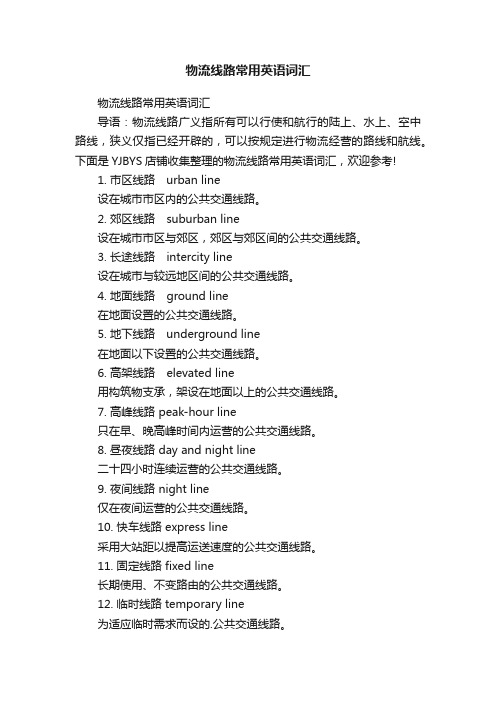
物流线路常用英语词汇物流线路常用英语词汇导语:物流线路广义指所有可以行使和航行的陆上、水上、空中路线,狭义仅指已经开辟的,可以按规定进行物流经营的路线和航线。
下面是YJBYS店铺收集整理的物流线路常用英语词汇,欢迎参考!1. 市区线路urban line设在城市市区内的公共交通线路。
2. 郊区线路suburban line设在城市市区与郊区,郊区与郊区间的公共交通线路。
3. 长途线路intercity line设在城市与较远地区间的公共交通线路。
4. 地面线路ground line在地面设置的公共交通线路。
5. 地下线路underground line在地面以下设置的公共交通线路。
6. 高架线路elevated line用构筑物支承,架设在地面以上的公共交通线路。
7. 高峰线路 peak-hour line只在早、晚高峰时间内运营的公共交通线路。
8. 昼夜线路 day and night line二十四小时连续运营的公共交通线路。
9. 夜间线路 night line仅在夜间运营的公共交通线路。
10. 快车线路 express line采用大站距以提高运送速度的公共交通线路。
11. 固定线路 fixed line长期使用、不变路由的公共交通线路。
12. 临时线路 temporary line为适应临时需求而设的.公共交通线路。
13. 游览线路 touring line为旅游专设的公共交通线路。
14. 环形线路 loop line围绕某一区域闭合运营的公共交通线路。
15. 干线 artery城市公共交通线路网中的主要线路。
16. 支线 branch围绕干线,扩大服务范围的辅助线路。
物流配送常用英文单词及常用句型

The material used to wrap or cover goods for protection during transportation
Transportation related
Freight
The goods are being transported
Cargo
The goods are being transported
Pipeline
for the transportation of goods through pipelines
Abbreviations for commonly used packaging
materials
Cardboard box
used for packaging and shipping items
Abbreviations for commonly used modes of transportation
Ocean
for sea transportation
Rail
for rail transportation
Air
for air transportation
Truck
for over the load transportation
Means
Sentence
Meanings
This presence expresses dissatisfaction with the delivery process and seeks assistance from the other party to resolve the issue.
"My package was delivered to the wrong address. What steps can you take to resolve this?"
考虑时效的应急物资配送路径优化方法
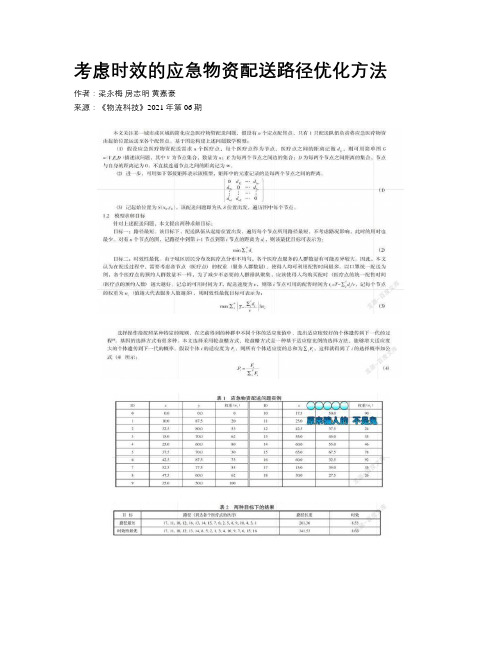
考虑时效的应急物资配送路径优化方法作者:梁永梅房志明黄嘉豪来源:《物流科技》2021年第06期摘要:针对城市区域的应急医疗物资配送问题,把医疗点作为节点,医疗点之间的路径作为边,构建了相应的应急医疗物资配送的图模型。
提出了两种面向实际需求的模型求解目标,一种是路径最短,该目标追求配送路径/用时最短,另一种是时效性最优,该目标追求人均可利用配售时间最多,以减轻人群聚集情景。
建立了基于遗传算法的应急医疗物资配送模型求解方法,并针对一个实例进行了计算分析,结果表明,路径最短的配送方案不一定能达到最优的人均配售时间,而如果想实现较多的人均配售时间,则可能需要花费较多的配送成本。
关键词:医疗物资;配送;路径;时效;遗传算法中图分类号:F252.14 文献标识码:AAbstract: In the event of an infectious disease epidemic, the rational dispatch and distribution of emergency medical supplies is the basis for epidemic prevention to ensure the safety of people's lives. Aiming at the problem of emergency medical supplies distribution in urban areas, taking medical points as nodes and paths between medical points as edges, a corresponding graph model of emergency medical material distribution is constructed. Two model solution goals oriented to actual needs are proposed. One is the shortest path, which pursues the shortest delivery route/time, and the other is the best timeliness, which pursues the maximum time available for allotment to reduce crowd gathering. A genetic algorithm-based emergency medical supplies distribution model solution method is then established, and calculation and analysis for an example is carried out. The results show that the shortest path distribution plan may not achieve the optimal per capita distribution time,and more per capita distribution time may require more travel costs.Key words: medical supplies; distribution; routing; timeliness; genetic algorithm0 引言自2019年底开始的新型冠状病毒肺炎疫情,给全球公共卫生带来了严峻的挑战。
基于GPS信息的物流配送车辆路径优化模型_英文_
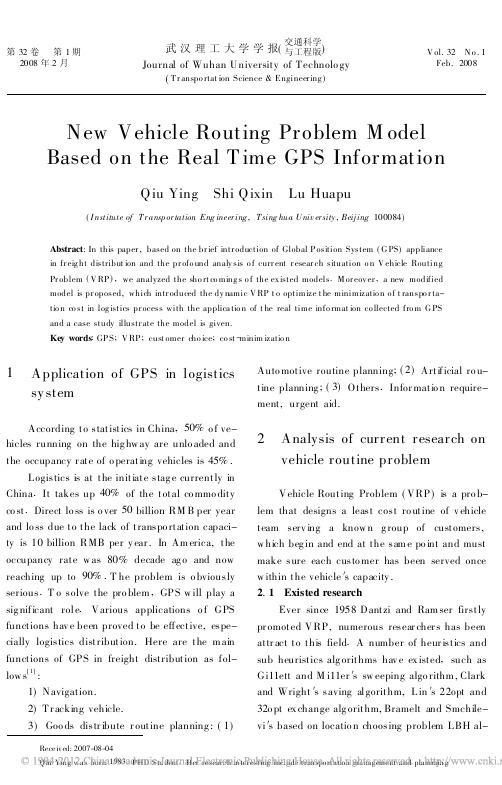
第32卷 第1期2008年2月武汉理工大学学报(交通科学与工程版)Journal of Wuhan University of Technolo gy(T r anspo rtat ion Science &Engineer ing )V ol.32 N o.1Feb.2008New Vehicle Routing Problem M odel Based on the Real T ime GPS Information Received:2007-08-04 Qiu Yin g w as born 1983.PHD S tu dent .Her research in teresting include tran sportation management and plammin gQ iu Ying Shi Q ixin Lu Huapu(I nstitute of T r ansp or tation Eng ineer ing ,T sing hua U niv er sity ,Beij ing 100084)Abstract :In this paper ,based on the br ief intr oduction of Global P osition System (G PS)appliance in fr eig ht distribut ion and the pr ofo und analy sis o f curr ent r esear ch situation o n V ehicle Routing Pr oblem (V RP ),we analyzed the sho rt co ming s o f the ex isted models .M or eov er ,a new modified model is pr oposed,which intr oduced the dy namic V RP t o optimize t he minimizatio n o f t ranspo r ta-tio n co st in log istics pr ocess with the applica tio n of t he real time info rmat ion co llected fro m G PS and a case study illustr ate the model is given.Key words :GP S ;V RP ;cust omer cho ice ;co st -minim izatio n1 A pplication of GPS in logisticssy stemAccording to statistics in China ,50%o f ve-hicles running on the hig hw ay are unlo aded and the occupancy r ate of o perating vehicles is 45%.Logistics is at the initiate stag e currently in China .It takes up 40%of the total co mmo dity co st .Direct lo ss is o ver 50billion RM B per year and lo ss due to the lack of transpo rtation capaci-ty is 10billion RMB per y ear.In Am erica,the occupancy rate w as 80%decade ag o and now reaching up to 90%.T he problem is o bviously serious .T o solve the pro blem ,GPS w ill play a sig nificant role .Various applications o f GPS functions hav e been proved to be effective,espe-cially logistics distribution.Here are the m ain functions of GPS in freight distribution as fol-low s [1]:1)Navigation.2)Tr acking vehicle.3)Goo ds distr ibute r outine planning :(1)Auto motive routine planning ;(2)Artificial ro u-tine planning ;(3)Others .Infor matio n require-ment,urgent aid.2 A nalysis of current research onvehicle routine problemVehicle Routing Problem (VRP)is a pro b-lem that designs a least cost ro utine of v ehicle team serv ing a know n g roup of customers,w hich beg in and end at the sam e po int and must make sure each custo mer has been served once w ithin the vehicle ′s capacity.2.1 Existed researchEver since 1958Dantzi and Ram ser firstly pr omoted VRP,numerous resear cher s has been attr act to this field .A number of heur istics and sub heuristics alg orithms hav e ex isted ,such as Gi11ett and M i11er ′s sw eeping algo rithm ,Clark and Wright ′s saving algorithm,Lin ′s 22opt and 32o pt ex change alg orithm,Bramelt and Smchile-vi ′s based on locatio n choosing problem LBH al-gor ithm,and recent year existed genetic alg o-rithm,neural netw or k,simulated annealing, Abu search and so on.Related liter atures in-clude M alandraki(1992,1996[2]),Russ J (1995),Jo ojung(2000),Yang By ung(2000), Sorrelm(2003),and Ambardella(2003)et al.A num ber o f ex perts resear ch on VRP in China at present,for instance,“Study on the Lo-gistics Distribution VRP Based o n Immune Al-gor ithm”(2003)[3],“Study on the Optim ization of Log istics Distributio n VRP Based on Im mune Clone Algor ithm”(2004)[4],“A GA-based Alg o-rithm Clustering Analysis in Delivery Vehicle Scheduling”(2004)[5],“Research of Vehicle Ro uting Pro blem U nder Condition of Fuzzy De-mand”(2004)[6]and so on.2.2 ProblemsExisted studies mo stly focus on analysis of long term records to find statistical rules of the statistic V RP.A few studies have been carried out in T ime Dependent VRP(TDV RP)m odel and alg orithm,and it is still at the initial stage. Sho rtcom ing s of current research include[7]:1)Ex ist algo rithms are not applicable for new problem.2)Research result o f dynamic VRP should be evaluated by data under real transpo rtation enviro nm ent.3)No enhancem ent has been pro posed yet.4)Research of dy nam ic random VRP,is far fr om enough.In this paper,w e promo ted an alg orithm based on fuzzy possibility and studied o n the im-pact of GPS inform ation on final decisio n objec-tiv es.3 M at hematical model of L ogistics distribution V RPLogistics distribution VPR can be described as follo ws:sev eral capacity definite vehicles take go ods from log istics center by w ay o f reasonable arranged routine w hich make the total haul dis-tance shortest,to several dem and points,posi-tio n and demand of w hich ar e certain,and meet-ing the fo llow ing conditio ns:1)Total dem and o f all points on each path no m ore than vehicle capacity.2)Distribution distance of each path should w ithin the distribution r ang e of vehicles.3)Each demand point served by one vehi-cle.3.1 Model hypothesisSet dynamic VRP mo del hypothesis as fol-low s:(1)In a distribution netw o rk,each of the N customer′s location and dem and is kno wn;(2) Vehicle capacity is definite,but quantity is un-certain;(3)VRP m odel is to meet all the cus-tomer′s dem and and m inimize cost of w ho le trip.3.2 ModelFactors affect the problem including:ware-ho use,vehicle,tim e-w indow,customer,ro ad inform ation,goo ds infor matio n,transpo rt reg u-latio n and so on.T he objectiv es ar e max imizing load rate and minim ize total cost.Set:(1)C is total co st;(2)D k is driving r ange of the v ehicle k;(3)L is num ber of demand points;(4)d ij is distance betw een i,j(i,j=1,2,…,L);(5)n k is demand po int of k to serve(n k=0Means it is not used);(6)R k is routine path collection of v ehicle k.Then w e get the optim ization mo del as fol-low sm in Z=∑Nk=1[∑nki=1d rk(i-1)rki+d rk nkrkosig n(n k)](1) That is the basic m odel to optim ize shortest path;anyw ay it does not mean cost m inimiza-tio n.Hereby w e com bine max imized load rate and m inimize distance to realize low est cost.Set A as load rate,meeting0≤A≤1,(1)When A=0is full load;(2)When A=1 is em pty;(3)When A is between0and1.Set C E per mile is the lo st of no t full load, A C E is the lost of unload,and C F is the full lo ad co st.The m odify model is as follo w s:min C=A C E D E+C F D F(2) Wher e:D E is not full lo ad driving distance;D F is・188・武汉理工大学学报(交通科学与工程版)2008年 第32卷full load driving distance;Z is to tal distance,Z =D E+D F.min C=C F Z+(A C E-C F)D E(3) (1)(A C E-C F)≥0,path sho rtest,co st least;(2)(A C E-C F)<0,other m inimum value.Obvio usly,the data from GPS dev ices gr eatly affect the m odel,w ith the r efreshment of w hich dynam ic path optimizatio n w ill be real-ized.Distribution VPR is com plex NP problem, herein w e introduce a new r estrict in to the func-tio n.4 Case studySuppo se ther e are5dem and points,3vehi-cles with5tons carry ing capacity.0stands for the center and1-5are the destination points. Demand and Distances ar e sho wn in the follow-ing T able1and Table2.Only point5could not directly connect with the center.Table1 Demand Quantity of Each Pointpo int12345 Demand(to n)42313Table2 Distance between logistics centerand demand point km center point 012345 001001001001001411100014120014117221001410141200172310020014101411004100141200141010051001721721001000 set a,b,c stand for the there trucks sepa-ratelyL T=L a+L b+L c=15(4)w here L a≤5,L b≤5,L c≤5.min C=C F Z+(A C E-C F)D E(5) Supposing GPS info rmation can accurately reflect the real state of tr uck lo ad,and then w e can g et real time value of A.Table3show s the progr am s the trucks can choo se from before depar ture.R ij stands for the jpath of i pr ogram.(Ignor e the case of any truck not w or k):Table3 Load Distribution and Path ChoosingPathL oada b cPr og ram1R1142+31+3R1243+21+3R1342+33+1R1443+23+1Pr og ram2R214+12+33R224+13+23R231+42+33R241+43+23 T hen w e calculated the cost o f each pro-gram,taking R12in prog ram1for instance.F ig.1 Distr ibutio n netw o rk and R outine o f R12 Fig.1show s the routine of R12.a,b,c stands for each truck:purple represent tr uck a, black b,or ange c.Arrow s are to wards driving direction.Considered oil consuming,w earing and la-bo r,suppose it costs1$per km w hen full lo ad and0.9w hen empty.Fig.2show s that vacancy running cost takes mo re than half o f total v alue, from w hich most increases o f cost com e.Even if full load cost decreased the total cost increase due to empty running,such as R22.T hat means reduce the empty running cost could bring g reat pr ofit and many measurem ents could do to r eal-ize it.Fig.2 Compar ison of co st s fo r each pr og ramAt the sam e tim e,w e can also see form the sketch,R12cost least884.54$w ith total ro utine leng th9.41km,w hile R24′s leng th is10.82km w hich costs m ost1250.9$.T hat means the routine optimization could reduce the cost a lot.・189・ 第1期Q iu Y ing,et al:N ew Vehicle Ro ut ing P ro blem M o del Based on the R eal T ime G PS Infor mationHow ever ,even if the r unning distance is the sam e ,the cost differences ar e g reat ,for exam ple R 12and R 13.It dem onstrates that only consider-ing routine o ptimization co uld not minim ize the co st,and increasing the full load rate is a better w ay.5 Conclusio nsThe paper demonstr ates that shot routines not necessar ily means low cost,and only routine optim ization is not enough .Individual prefer ence w ould also influence the result.IT S inform ation is quite useful in practice and has great effect on the model.Parameter m odify w ill induce g reat change to the routine cho se ,and then influence the cost.T he advanced r esearch on GPS infor-mation collection,application,analysis andpr actical GPS technology are very m eaning ful for the logistics development in China .Ref erences[1]Guo Cheng.A na ly sis of applicat ion o f GP S in log is-tics dist ribution [J ].L og istics T echnolog y ,2002(6):11-12.[2]M a landraki.A restr icted dynamic pr og r amming heu-r istic algo rithm fo r the time dependent t rav eling salesm an pro blems,Euro pean [J ].Jour nal of Oper a-tional R esea rch,1996,90:45-55.[3]Q i Xia,Chen Senfa,Huang K un,et al.Study onthe lo gist ics distr ibut ion V RP based on immune al-go rithm[J].China Civil Engineer ing Jo ur nal,2003,36(7):43-46.[4]Zhang Jing ,Zho u Q uan .Study o n the o ptimizationof lo gistics distr ibutio n V RP based on immune clone algo rithm[J].Jo urnal o f Huna n U niv ersity :N atural Sciences,2004,31(5):54-58.[5]Song Yulin ,Qi Huan .A G A -based alg or ithm clus-t ering analysis in deliver y v ehicle scheduling [J ].Co mput er and Dig ital Engineering ,2004,32(2):45-47.[6]Zhang Jiany ong ,G uo Y ao huang ,Li Jun .Researcho f v ehicle ro uting pro blem under condition o f fuzzy demand[J ].Jour nal of System Engineer ing ,2004,19(1):74-78.[7]Xia o Zengmin ,Li Jun .V ehicle ro uting pro blem indy namic net wo rks:r esearch status and pro spect [J].System Eng ineering ,2004,22(7):68-71.基于GPS 信息的物流配送车辆路径优化模型邱 颖 史其信 陆化普(清华大学交通研究所 北京 100084)摘要:物流配送车辆路径优化是物流领域中亟待解决的重要问题和研究热点.本文通过对国内外物流车辆路径优化研究现状的分析研究,以及GP S 等智能交通技术在该领域中的应用现状分析,以最小化物流运送成本为优化目标,引入动态V RP 和不确定影响因素,提出了一种改进的新模型,利用已有的算法,并通过算例对模型算法进行检验.关键词:G PS;动态V RP ;成本最小化中图法分类号:U 116.2(上接第155页)abo ut the characteristic of the system are educed using mathematic mo del and Chapm an Kolmo gor ov equation.T he Smoo thed Perturbation Analysis method is em ploy ed for sensitivity analysis.Key words :M/D/c queuing netw ork;index of efficiency ;sensitivity ;smoo thed Per turbation Analysis・190・武汉理工大学学报(交通科学与工程版)2008年 第32卷。
写关于如何提高配送效率的英语作文

写关于如何提高配送效率的英语作文英文回答:Improving Delivery Efficiency.Delivery efficiency is crucial for businesses to maintain customer satisfaction, optimize operations, and reduce costs. By implementing effective strategies, companies can improve the speed, reliability, and accuracy of their delivery processes, leading to increased profitability and enhanced customer experiences. Here are some proven techniques:1. Optimize Route Planning:Leverage technology to optimize delivery routes, minimizing travel time and fuel consumption. Utilize AI-powered algorithms that consider real-time traffic data, vehicle capacity, and delivery constraints to create efficient routes that maximize deliveries per hour.2. Centralize Distribution Centers:Consolidate inventory in strategically located distribution centers to reduce delivery distances and transit times. This allows for faster delivery to a broader geographic area while reducing transportation costs.3. Implement Real-Time Tracking and Communication:Provide customers with real-time visibility into the status of their deliveries. Use GPS tracking devices and mobile apps to keep customers updated on delivery progress, ETA, and estimated delivery time. This transparency builds trust and enhances the customer experience.4. Utilize Technology for Automated Processes:Automate manual tasks such as order processing, inventory management, and route planning. By leveraging software and automation tools, businesses can streamline operations, reduce errors, and improve delivery accuracy.5. Optimize Vehicle Capacity and Load Planning:Maximize vehicle capacity by carefully planning load distribution. Utilize load optimization software that considers package dimensions, weight, and constraints to ensure optimal vehicle utilization, reducing wasted space and transportation costs.6. Train and Develop Drivers:Invest in training and development programs fordelivery drivers. Proper training on efficient driving techniques, safety protocols, and customer serviceetiquette ensures that drivers are well-equipped to handle complex delivery scenarios effectively.7. Foster Collaboration with Carriers:Establish strong partnerships with carriers andactively manage relationships. Collaborate on route optimization, capacity planning, and performance monitoringto ensure seamless delivery operations and reduce potential delays.8. Monitor and Analyze Performance:Continuously monitor and analyze delivery metrics to identify areas for improvement. Use performance dashboards and reports to track key indicators such as delivery time, accuracy, and customer satisfaction. This data-driven approach enables data-backed decision-making for process optimizations.9. Seek Customer Feedback:Encourage customer feedback to gather valuable insights into the delivery experience. Conduct surveys and collect customer testimonials to identify areas where processes can be improved. This feedback loop helps businesses enhance service quality and meet customer expectations.10. Explore New Technologies and Innovations:Stay abreast of emerging technologies that can further enhance delivery efficiency. Consider using drones forlast-mile deliveries, leveraging AI for predictive analytics, and implementing automated delivery lockers for secure and convenient package retrieval.中文回答:提高配送效率。
在物流领域,流程优化的英语单词缩写
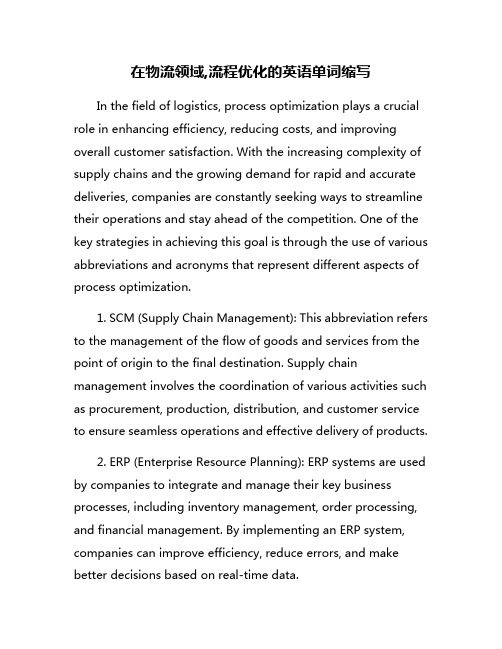
在物流领域,流程优化的英语单词缩写In the field of logistics, process optimization plays a crucial role in enhancing efficiency, reducing costs, and improving overall customer satisfaction. With the increasing complexity of supply chains and the growing demand for rapid and accurate deliveries, companies are constantly seeking ways to streamline their operations and stay ahead of the competition. One of the key strategies in achieving this goal is through the use of various abbreviations and acronyms that represent different aspects of process optimization.1. SCM (Supply Chain Management): This abbreviation refers to the management of the flow of goods and services from the point of origin to the final destination. Supply chain management involves the coordination of various activities such as procurement, production, distribution, and customer service to ensure seamless operations and effective delivery of products.2. ERP (Enterprise Resource Planning): ERP systems are used by companies to integrate and manage their key business processes, including inventory management, order processing, and financial management. By implementing an ERP system, companies can improve efficiency, reduce errors, and make better decisions based on real-time data.3. WMS (Warehouse Management System): A WMS is a software application that helps companies control and optimize warehouse operations, including inventory management, order picking, and shipping. By using a WMS, companies can improve inventory accuracy, reduce labor costs, and increase order fulfillment speed.4. TMS (Transportation Management System): A TMS is a software solution that helps companies manage and optimize their transportation operations, including carrier selection, route planning, and freight payment. By using a TMS, companies can reduce transportation costs, improve delivery times, and enhance visibility across their supply chain.5. EDI (Electronic Data Interchange): EDI involves the electronic exchange of business documents such as purchase orders, invoices, and shipping notices between trading partners. By using EDI, companies can automate data exchange, reduce errors, and improve the efficiency of their supply chain processes.6. 3PL (Third-Party Logistics): 3PL providers offer outsourced logistics services to companies, including transportation, warehousing, and distribution. By partnering with a 3PL provider,companies can access specialized expertise, scale their operations, and focus on their core business activities.7. KPI (Key Performance Indicator): KPIs are metrics used by companies to evaluate the performance of their logistics operations and track progress toward their goals. By monitoring KPIs such as on-time delivery, order accuracy, and inventory turnover, companies can identify areas for improvement and make data-driven decisions.8. JIT (Just-in-Time): JIT is a logistics strategy that aims to minimize inventory holding costs by delivering products to customers just in time to meet demand. By implementing a JIT system, companies can reduce lead times, improve cash flow, and increase operational efficiency.Overall, by leveraging these and other abbreviations and acronyms related to process optimization in logistics, companies can drive continuous improvement, achieve operational excellence, and deliver value to their customers. By staying informed about best practices and emerging technologies in the field, companies can stay competitive and adapt to theever-changing demands of the global marketplace.。
物流流程优化的案例英语
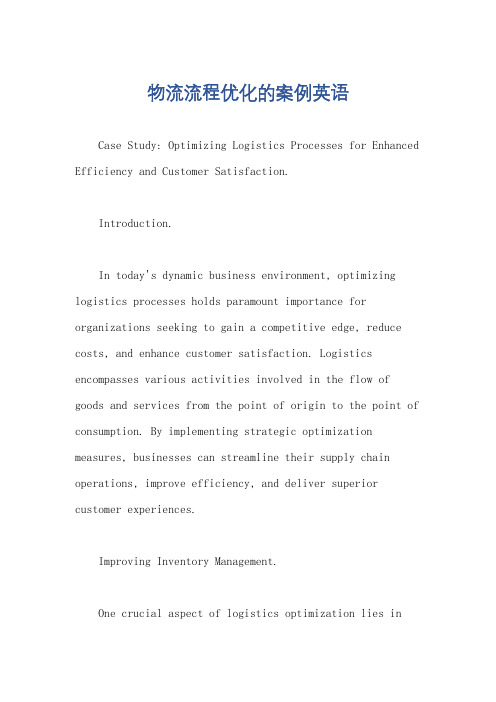
物流流程优化的案例英语Case Study: Optimizing Logistics Processes for Enhanced Efficiency and Customer Satisfaction.Introduction.In today's dynamic business environment, optimizing logistics processes holds paramount importance for organizations seeking to gain a competitive edge, reduce costs, and enhance customer satisfaction. Logistics encompasses various activities involved in the flow of goods and services from the point of origin to the point of consumption. By implementing strategic optimization measures, businesses can streamline their supply chain operations, improve efficiency, and deliver superior customer experiences.Improving Inventory Management.One crucial aspect of logistics optimization lies inimproving inventory management practices. Organizationsneed to strike a balance between maintaining adequate inventory levels to meet customer demand and minimizing overstocking, which can lead to increased carrying costsand potential spoilage. Advanced inventory management systems can be employed to monitor stock levels in real-time, forecast demand patterns, and optimize replenishment strategies. This ensures that inventory is always available when needed, reducing the risk of stockouts or excess inventory.Optimizing Transportation and Distribution.Transportation and distribution play a significant role in the logistics process. By optimizing these operations, businesses can reduce transportation costs, improvedelivery times, and enhance the overall customer experience. Implementing techniques such as route optimization, load consolidation, and carrier management can helporganizations minimize fuel consumption, reduce transit times, and enhance delivery reliability. Advanced technologies like GPS tracking and vehicle telematicsprovide real-time visibility into transportation activities, enabling efficient route planning and proactive problem-solving.Enhancing Warehouse Operations.Warehouses serve as vital hubs within the logistics network, responsible for receiving, storing, and shipping products. Optimizing warehouse operations involvesimproving space utilization, reducing handling times, and enhancing picking and packing efficiency. Implementing automated storage and retrieval systems (AS/RS), usingradio frequency identification (RFID) technology for inventory tracking, and adopting lean principles can significantly improve warehouse operations, increasing throughput, reducing labor costs, and minimizing errors.Integrating Information Technology.Information technology has become an integral part of modern logistics processes. Integrating advanced IT systems, such as enterprise resource planning (ERP) andtransportation management systems (TMS), provides organizations with real-time visibility into supply chain operations. These systems facilitate seamless data sharing, automate repetitive tasks, and enable data-driven decision-making. By leveraging technology, businesses can gain insights into logistics performance, identify bottlenecks, and implement effective optimization strategies.Case Example: Amazon's Logistics Optimization.Amazon, a global e-commerce giant, serves as a prime example of how logistics optimization can drive business success. The company has invested heavily in optimizing its entire supply chain network, from inventory management to transportation and delivery.Inventory Management: Amazon uses advanced algorithms and predictive analytics to forecast demand and optimize inventory levels. This ensures that products are always available while minimizing overstocking.Transportation and Distribution: Amazon's proprietarytransportation network, including airborne, ground, and maritime services, enables efficient and reliable delivery. Route optimization and load consolidation techniques minimize transportation costs and reduce delivery times.Warehouse Operations: Amazon's highly automated warehouses utilize robotics, conveyor systems, and advanced inventory management technologies to achieve exceptional picking and packing efficiency. This allows the company to process orders quickly and accurately, ensuring fast and reliable delivery.Technology Integration: Amazon's advanced IT systems provide real-time visibility into supply chain operations, facilitate data sharing, and enable data-driven decision-making. The company's customer-facing app provides real-time delivery updates and allows customers to track their orders.Conclusion.Logistics optimization is a multifaceted endeavor thatrequires a comprehensive approach to improve efficiency, reduce costs, and enhance customer satisfaction. By implementing strategic measures across the entire supply chain, from inventory management to transportation, distribution, and warehouse operations, organizations can achieve significant improvements. Integrating advanced information technology and leveraging data-driven insights provide a powerful foundation for continuous optimization. Case studies, such as Amazon's logistics optimization strategy, demonstrate the transformative impact that optimization can have on business performance. By embracing a holistic and data-driven approach, organizations can unlock the full potential of their logistics operations and gain a competitive edge in the global marketplace.。
- 1、下载文档前请自行甄别文档内容的完整性,平台不提供额外的编辑、内容补充、找答案等附加服务。
- 2、"仅部分预览"的文档,不可在线预览部分如存在完整性等问题,可反馈申请退款(可完整预览的文档不适用该条件!)。
- 3、如文档侵犯您的权益,请联系客服反馈,我们会尽快为您处理(人工客服工作时间:9:00-18:30)。
City Emergency Logistics Delivery Path Optimization
Introduction
With the rapid development of urbanization and the expansion of urban populations, the challenges faced by city emergency logistics delivery have become increasingly complex. During emergency situations such as natural disasters or public health crises, the efficient distribution of goods and resources is crucial to ensure the well-being and safety of
city residents. This article aims to explore the optimization of city emergency logistics delivery paths, focusing on improving response times, reducing costs, and enhancing overall effectiveness.
Challenges of City Emergency Logistics Delivery
1.Limited Resources:
–In emergency situations, resources such as medical supplies, food, and water are often limited. It is essential to ensure
these resources are distributed efficiently to areas in need.
–The scarcity of resources during emergencies poses a
significant challenge, as it requires careful planning and
coordination to ensure equitable distribution.
2.Traffic Congestion:
–Urban areas are susceptible to traffic congestion, which can significantly hinder emergency logistics delivery.
–Traffic congestion not only delays response times but also increases overall costs. Finding the most optimal delivery
routes is crucial to avoid congested areas and reach
destinations quickly.
3.Real-time Information:
–Real-time information on the situation and demand is vital in emergency logistics delivery.
–The ability to track and monitor the delivery process allows for better coordination and timely adjustments to ensure
efficient distribution.
Optimizing City Emergency Logistics Delivery Paths
1. Utilizing Geographic Information Systems (GIS)
Using GIS technology can greatly assist in optimizing city emergency logistics delivery paths. GIS maps can provide valuable information on road conditions, traffic congestion, and alternate routes, allowing for better decision-making in real-time. By integrating GIS into the logistics system, it becomes possible to identify the most efficient paths for delivering goods and resources during emergencies.
2. Implementing Dynamic Routing Algorithms
Dynamic routing algorithms, such as the Ant Colony Optimization (ACO) algorithm, can be utilized for optimizing emergency logistics delivery paths. These algorithms consider factors such as traffic conditions, road capacity, and delivery time windows to determine the most efficient routes. By constantly adjusting and updating routes based on real-time data, these algorithms can minimize delivery times and costs.
3. Establishing Emergency Distribution Centers
Establishing emergency distribution centers strategically throughout the city can facilitate swift and efficient logistics operations. These centers can act as hubs for storing emergency resources and can be equipped with advanced technologies for sorting and distribution. By strategically locating these centers, it becomes easier to reach affected areas quickly during emergencies.
4. Collaborating with Local Authorities and Organizations
Collaboration with local authorities, non-governmental organizations (NGOs), and other relevant stakeholders is crucial in optimizing city emergency logistics delivery paths. By working together, information sharing becomes more efficient, and resources can be better allocated based on demand. Collaborative efforts can also lead to the establishment of protocols and contingency plans that enhance overall responsiveness and effectiveness.
Conclusion
Optimizing city emergency logistics delivery paths is essential to ensure timely and efficient distribution of goods and resources in times of crises. By utilizing GIS technology, implementing dynamic routing algorithms, establishing emergency distribution centers, and promoting collaboration among various stakeholders, cities can overcome the challenges posed by limited resources and traffic congestion. Effective emergency logistics delivery plays a vital role in saving lives, reducing the impact of disasters, and ensuring the well-being of city residents.。
